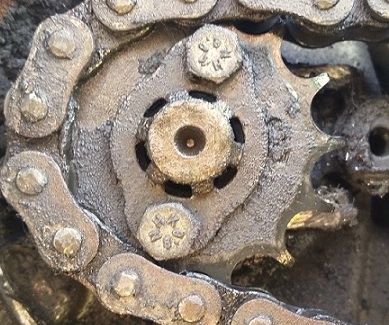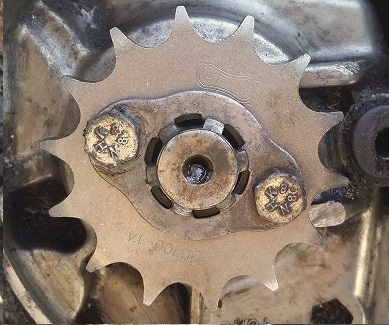allanwallace.uk : CG125 : Tips
How to make your CG125 go faster
1 - Change the oil.
(assuming you haven't recently - or run cheap oil)
I prefer Silkolene PRO 4 10w40 1L - as it performs well and at approx 850ml per fill, every 6th fill is "free".
- as it performs well and at approx 850ml per fill, every 6th fill is "free".
(Over a 942 metre stretch of tarmac i hit a 5mph higher top speed today - 19th April 2018 - than with the 1498.7 mile old oil immediately prior.)
It's red. If you damage your bike and it bleeds, then you have a problem requiring investigation.
This happened about a week before my CG125 bled:

This AFAM sprocket was a replacement for a genuine Honda sprocket
The alignment of the teeth to the holes differs from the genuine Honda sprocket
Genuine Honda CG125 Front Sprocket:

The bolt holes align with the teeth.
vs AFAM CG125 front sprocket:

The bolt holes do not align with the teeth.
I think this issue is more prone to happening with an AFAM front sprocket
- if the edges of the bolt heads aren't carefully aligned chain can catch.
I swapped the two bolts over and reassembled it and it has been fine since.
Would I use an AFAM sprocket in future? - Definitely, much more cost-effective than Honda.
- Just keep a close eye and ear on it.
Tip: First clue was a sound a bit like a metal pad-less brake pad against a brake disc....
Anyway, putting Silkolene PRO 4 10w40 1L in a CG-125, is a bit like feeding caviar to a pig
2 - Lose weight.
You - not the CG125 - it's not fat.
Admittedly if it is a model with starter motor or kickstart you could remove the starter motor and /or kickstart to save some weight.
With a 5 speed box you can bump-start at a brisk walking pace using 3rd gear and dumping the clutch.
Just bear in mind, that is low-down weight. If you remove it, you increase the CoG (Centre of Gravity).
3 - Carry a suitably shaped rucksack on your back
The Hi-viz myth
I once read that the highest speed attained would be through the use of a Hi-viz, and for over two years the highest indicated speed I had seen out of my Honda CG125-ES4, was when I was carrying a hi-viz jacket in my rucksack.
I also had a very strong tailwind and was going down a long, steep hill, but that's purely co-incidence...
The 2nd time was the same long steep hill, in the same direction, with a very strong tailwind, with no hi-viz, but wearing the same rucksack,
and the maximum indicated speed was equalled.
I suspect the shape of the rucksack contributes to aerodynamics, I guess it's possible that the material most hi-viz jacket's are made from could to, but most likely to laminar airflow.
Maybe it's a better thing to cover the tank with. Oh now there's a idea.
4 - Sell it for a profit and use the money to buy a faster bike
If you have an average age/miles CG125, as long as you maintain and repair it, and don't modify it then it is unlikely to decrease in value.
New bikes on the other hand can lose value quite quickly, so while I like the look of this:
Honda CB125R Neo Sports Café
5 - Aerodynamics
The average CG125 has very little in the way of power, from what I've read a "good" one will have a little over 11 BHP.
With so little power available, anything you can do to increase the effect of that limited amount of power will help.
On that note, above 56MPH (approx) wind resistance is the biggest thing hampering an increase in speed.
If you want to increase your maximum speed, you need to make aerodynamic changes first.
And only then think about sprockets.
Options
• Lower flatter Handlebars
• Indicators.
• Mirrors.
• Minimum legal size number plate. You only need 11mm around the outside of the letters.
• Change the number plate for one with less letters and numbers. See above.
• Install fairing. Will generally add weight.
I think the last two options are starting to get expensive.
6 - Performance Increases
I list this point last for two reasons:
Cost
Reduction in reliability
On the subject of reliability, the causes of engine mechanical failure I have heard of happening to standard CG125 engines are as follows:
• Piston Ring failure
• Piston failure
• Exhaust valve dropping
• Broken con rod
(discovered today 14th July 2019 via the Honda CG125 Owners UK facebook group)
(further information on the last point two points is required)
I don't know which of these three is the most common, and I'm not sure how common these things are, but if you are going to thrash a standard engine, the above things are known risks.
If you are going to modify your engine for performance reasons I expect the above may become more common.
Me? - I'd rather find out the root causes of the above and mitigate them first. If however you are undettered, read on:
Performance Options
Lets have some maths first.
Stoichometric air/fuel ratio: 14.7 grams : 1 gram
Air weighs 1.2929 kilogram per cubic metre (1000 litres).
1kg of fuel burnt produces 2.29kg of co2.
124cc, which I am going to round up to 125cc*.
A 4-stroke engine only intakes once per four cycles.
A CG125-ES4 will arguably max out at 12000RPM*.
----------------
12000 RPM / 4 strokes = 6000 intakes per minute, 6000 exhausts per minute.
6000 x 125cc = 750 litres per minute.
(absolute maximum intake total flow rate @ 100% efficiency @ 1 atm / 1 bar / 14.7 psi)
= 969 grams air.
= 65.9 grams of fuel, 150.9 grams co2 @ stoichometric ratio.
Maximal theoretical fuel consumption: 65.9 grams per minute @ 12000 RPM.
= 3954 grams per hour, approximately 5.3 litres per hour, or just under 1.17 imperial gallons per hour at approx 88mph.
Why 88 mph? - Back to the Future is my inspiration for that, I'm fairly certain this is not achieveable with a standard engine unless you have the steepest piece of tarmac in the world...
and a following wind...
and an aerodynamic rucksack...
Clearly a standard CG125 is exceptionally unlikely to ever hit 88 mph, which means fitting an air intake that can flow 750 litres per minute is ridiculously oversized for a standard engine.
Incidentally, the calculator here: https://www.widman.biz/English/Calculators/CFM.html says 600 litres per minute.
Similar is true of the exhaust although it will be flowing more substantially hotter air relative to the intake.
Anyway, my point is this:
Before you start modifying, you ideally need to know the theoretical maxima for inlet diameter and exhaust diameter, which gives you a good starting point to work down from.
(or up, if you've gone the big barrel & piston route....)
I've got more to add to this, but I need to do some fact-checking first....
i.e.
The maximum air intake rate will never be above 750 litres per minute, because it can never reach 750 litre per minute.
Guess what one of the controlling factors for exhaust size is?
Flow rate.
By this point it should be apparent that there are values we can use as baseline maximums for air intake and exhaust diameter, values it would be generally pointless to go above.
For arguments sake, keeping the numbers artificially high, I am going to add fuel to the excessively big airflow figure of 750 litres per minute using stochiomatic ratio of approx 14.7 : 1 air:fuel.
Interesting note: 14.7 psi is approximately 1 bar / 1 atmosphere of pressure. A handy number to remember.
375 litres per minute / 14.7 = 25.5 litres per minute.
hahahha as if.
See how batshit these numbers are?
Lets use MPG and work backwards.
• Exhaust
Requires Carburetor and possibly air intake changes to compensate.
• Fuelling
May not require changes to exhaust.
Based on what I have read it is possible to get more power out of a CG125.
The "easy" option involves increasing the cubic capacity, at which point it typically becomes illegal for road use by A1 licence holders or those on L plates.
Most of these barrel and piston kits may require opening out of the crankcase, a job generally best done by a machine shop.
If reusing the same head it should be skimmed, a job generally best done by a machine shop.
This increases costs.
7 - Reduce rolling resistance
Seriously, a CG125 has so little power every little bit of help matters.
I don't have any energy efficiency figures for the various tyre choices, but it will make a difference.
I have not tried Metzeler ME22 but currently I am the biggest fan of Michelin Pilot Street tyres.
Michelin Pilot Street:
Front: Michelin Pilot Street 2.75 - 18 42P
Rear: Michelin Pilot Street 90/90 - 18 57P
Metzeler ME22:
Front: Metzeler ME22 2.75 - 18 48P
Rear: Metzeler ME22 90/90 - 18 57P
How to make your CG125 STOP faster Possibly more important.
Older models: Fit a CG125-ES4 front end:
Some say they do not rate the front disc brake on the CG125-ES4
-I'm thinking primarily of the hondacg125.awardspace.com site, sadly only partially available now via:
web.archive.org/web/20181002123339/http://hondacg125.awardspace.com/
- yet of the bikes I have ridden the disc brake on my CG125-ES4 is my favourite.
I am not sure why that site said:
"The only way to get the Nissin pads to work is to heat them up by braking a lot before you actually need them.
My biggest concern is when you need to brake heavily or in an emergency I found the pads friction disappears
(feels like the disc is as slippery as ice)."
To be accurate: This is not my experience of the standard brakes
- apart from in first few usages of brand new pads or a rebuilt caliper
- where the brake lever starts off weak and will touch the bar if pulled fully back.
Top Tip
How I break in new genuine Honda CG125 brake pads:
Repetitive emergency stops from 30 mph or so for a couple of miles.
That's basically it. Nothing else. Accelerate to 30, emergency stop, repeat.
Do a couple of miles then let it rest for an hour.
If it's still not getting there, repeat.
My brakes are standard.
It has standard genuine Honda CG125 brake pads made by Nissin.
I can lock the front up if I really want it to at any speed.
- I've locked the front brake up 3x at 60mph, I've not tried faster...
- I have locked it up at around 10mph in the sub-zero cold too - front end washed out
I caught the bike before it hit the deck, riding with your feet near ground level is a good idea at times...
In the dry I can typically stop what seems like very quickly in what seems like a very short distance,
and good brakes relly on good tyres.
I take it easier in the wet, much easier to lock the front up.
I have not tried Metzeler ME22 but currently I am the biggest fan of Michelin Pilot Street tyres.
p.s.
It's the same front disc brake, pads, and disc combination that the Brazilian CG150 uses, so it's more than capable for a little light tuning.
p.p.s
I have ridden a Derbi Crosscity on tarmac and tyres with less grip, and a much harder acting front brake. I found it potentially dangerous.
The best brakes are ones with variability you can feel, not necessarily the strongest.
Last Updated 2022/04/12 21:50 CET.
Cookie Policy
Privacy Policy
Security Policy
Terms & Conditions
© 2019 Allan Wallace


